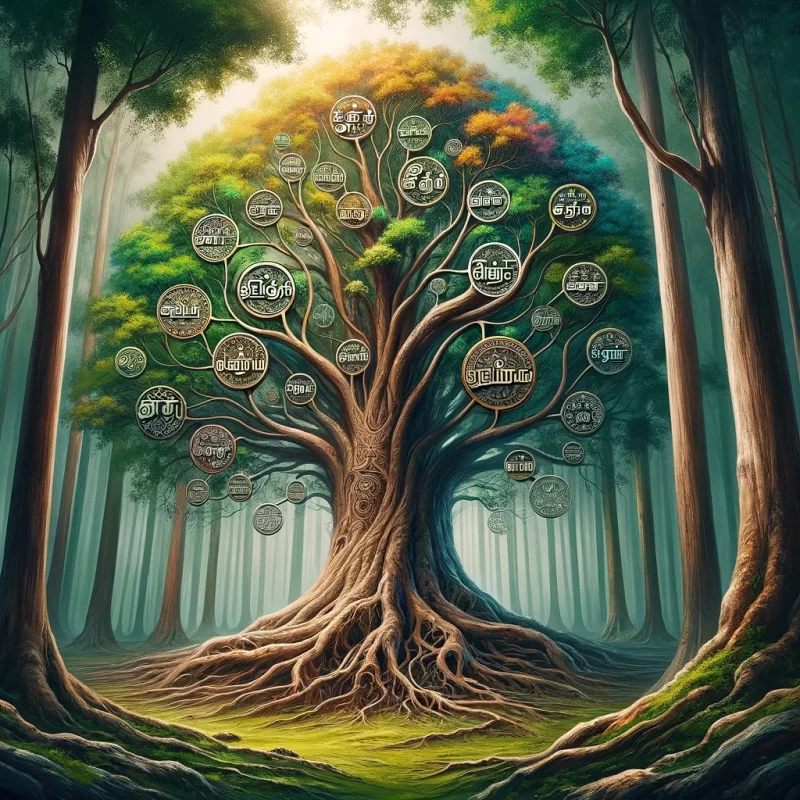|
Getting your Trinity Audio player ready...
|
The name we use for one of the major language families of South Asia is rife with colonial baggage and linguistic inaccuracy. For over 150 years, the term “Dravidian” has persisted, despite being a Sanskrit-derived misnomer that obfuscates the family’s true Tamil origins. It’s high time we rectify this injustice through a long-overdue renaming to “Tamilian” (தமிழியம்).
Why “Dravidian” is Problematic
The “Dravidian” label was coined in 1856 by British linguist Robert Caldwell, deriving it from the Sanskrit word “drāviḍa” used to refer to the geographic region of South India and its inhabitants. However, as Caldwell himself admitted, these languages have no genetic relationship to Sanskrit or other Indo-European tongues. Applying a Sanskrit name to an entirely unrelated language family represented the colonial-era biases and Eurocentric framing rampant in early linguistics scholarship on South Asia.
Even more troubling, the term’s Sanskrit roots reflect an external geographic labeling practice used by ancient Hindu texts to describe culturally and linguistically distinct local populations. This exogenous framing disregards the actual identities and linguistic realities of the speech communities themselves. In our modern post-colonial context, perpetuating the “Dravidian” misnomer serves to erase the family’s indigenous Tamil roots.
The Evidence for a Tamilian Core
Extensive evidence from comparative linguistic analysis, historical linguistics, glottochronology, and quantitative statistical methods consistently indicates that Tamil represents the oldest, most archaic, and prototypical branch that aligns closest with reconstructions of the proto-language, warranting recognition as the core source.
Linguistic Data:
Tamil exhibits deeply conservative phonological, grammatical, and lexical features that have remained closest to proto-Dravidian roots, while other major literary languages underwent greater degrees of innovation over time.
Core vocabulary: Tamil shares significant lexical roots for basic vocabulary with proto-Dravidian reconstructions.
Literary Tradition: The oldest continuous textual records in any Dravidian language are Tamil’s Sangam classics and the ancient Tolkāppiyam grammar work, predating literary sources from other branches by centuries or millennia.
Inscriptions: Crucially, early Dravidian language inscriptions from major sites across South Asia like the Indus Valley use Tamili script (Tamil-Brahmi) variants, highlighting Tamil’s historical primacy.
Essentially, if languages are like trees with branches, Tamil represents the oldest, sturdiest core trunk from which other Dravidian tongues branched out and diverged over time. Its linguistic profile most closely adheres to the proto-source, just as families like Indo-European and Sino-Tibetan are named for their primordial ancestral contributors. Calling this family “Tamilian” would finally realign its nomenclature with linguistic reality.
Comparative Linguistic Analysis:
Systematic comparisons across the major Dravidian subgroups demonstrate Tamil’s archaic retentions versus shared innovations in other branches. For example, the retention of ancient phonemes like /ḻ/, proto-grammatical archaisms in verb morphology and case marking, and a core vocabulary stratum mapping faithfully to reconstructed proto-forms.
Using computational phylogenetic models, we can quantify Tamil’s relatively higher degree of linguistic proximity and lower measured divergence from the proto-language compared to other subgroups. These methods infer proto-Dravidian as the clear genomic precursor radiating outwards along a branching tree structure, with Tamil representing the trunk closest to that root state.
Historical Linguistics: In-depth reconstruction work charts the linguistic evolution from proto-Dravidian roots to modern Tamil via principled sound changes and rule mappings. This diachronic analysis reinforces Tamil’s conservative profile retaining key ancestral traits.
The Linguistic Paleontology of reconstructed proto-vocabulary offers glimpses of the ancestral Dravidian homeland’s flora, fauna, and cultural context, strongly pointing towards Tamil Nadu as the Urheimat region.
Moreover, the chronological antiquity of Tamil’s linguistic influences manifests across other Dravidian branches through loanword and contact evidence accumulated over vast timescales.
Glottochronology:
Applying techniques like lexicostatistical modeling yields estimated chronological ranges for when Tamil first diversified from other Dravidian subgroups that align remarkably with archaeological dates for prehistoric migrations and population expansions from Tamil Nadu across south India and beyond.
At higher subgroup levels, glottochronological calculations suggest the initial proto-Dravidian diversification into daughter branches may trace back over 4-5 millennia, consistent with Tamil literary traditions’ antiquity.
Statistical Linguistics:
Bayesian phylogenetic analyses and computational cladistics methods demonstrate Tamil’s ancestral position at the root of the Dravidian family tree topology. Statistical models quantify Tamil’s higher statistical conservatism across linguistic traits compared to reconstructed proto-norms versus other languages’ divergent character states.
Integrating these multidisciplinary historical linguistic methodologies offers a vastly enriched empirical foundation situating Tamil as the prototypical core of this language family. From every angle – comparative analysis, linguistic paleontology, glottochronology, and quantitative phylogenetics – the evidence consistently highlights the unrivaled archaicity and central phylogenetic role of the Tamil branch.
Early Western Recognition of Tamil Primacy
The historical record reveals that even early Western linguists recognized the centrality of Tamil within this language family, often preferring terminologies that reflected this reality. Professor Max Müller, one of the most influential 19th-century linguists, originally classified these languages as “Tamulic” in his seminal work Lectures on the Science of Language, explicitly acknowledging Tamil as the foundational source from which Malayalam, Kannada, and other related languages emerged. Similarly, other prominent scholars like H.P. Hetsen, Professor R.E. Roberts, and Stephenson conducted exhaustive research establishing that these languages existed independently without dependence on Sanskrit or other Indo-European tongues. Even Colebrooke’s early observations noted the distinct character of Tamil, recognizing that the word as “pronounced by the natives, is Tamil or Tamal,” potentially deriving from significant geographical markers like the Tamraparni river. This early scholarly consensus toward “Tamulic” nomenclature demonstrates that the linguistic evidence for Tamil’s primordial role was apparent from the very beginning of systematic study.
Caldwell’s Own Hesitation and the Path Not Taken
Perhaps most tellingly, even Robert Caldwell himself, the architect of the “Dravidian” terminology, originally considered using “Tamulic” before ultimately settling on his Sanskrit-derived alternative. In his Comparative Grammar of Dravidian Languages, Caldwell acknowledged his initial preference for the more linguistically accurate “Tamulic” designation but ultimately abandoned it due to concerns that speakers of other languages within the family might object to Tamil being given such prominent nomenclatural recognition. This admission reveals that Caldwell’s choice of “Dravidian” was not based on linguistic evidence but rather on political considerations and a desire to avoid inter-community tensions. His decision represents a compromise that prioritized diplomatic convenience over scientific accuracy—a colonial-era accommodation that inadvertently established a misnomer that has persisted for over 150 years. Had Caldwell followed his initial linguistic instincts and the precedent set by Müller and other scholars, the field would have been spared this prolonged terminological inaccuracy, and the family would have been correctly identified as “Tamilian” from the outset.
This wealth of convergent technical scrutiny renders Tamil’s qualification as the root ancestral source unimpeachable. As the demonstrable prototypical exemplar mapping most faithfully onto proto-Dravidian origins, Tamil rightfully merits explicit nomenclature recognition through the more etymologically accurate designation “Tamilian” for this language family.
The Push for Decolonization
Beyond just linguistic accuracy, transitioning away from the “Dravidian” colonial misnomer represents an opportunity for decolonization and reclaiming the indigenous identity of these speech communities.
For too long, the externally imposed Sanskrit-rooted label has caused these languages to be framed through the lens of the dominant Indo-Aryan cultural complex, rather than their own authentic roots and historical identity. Renaming as “Tamilian” would decouple this family’s identity from that problematic exonym.
Of course, such a monumental shift in entrenched academic terminology governing millions of language speakers must be executed thoughtfully to address socio-political concerns around ethnic identities, nationalism, and pan-Dravidian solidarity. Inclusive efforts reassuring all sub-groups that their equal representation is maintained under the new “Tamilian” banner would be crucial.
A Roadmap for Change
So just how could the “Tamilian” shift be implemented? Here’s a potential multi-phase roadmap:
- Phase 1) Building consensus across linguistic societies, government language bodies, and key stakeholders through conferences and publications making the evidence-based case.
- Phase 2) Formal adoption in linguistics education curricula and instructional materials.
- Phase 3) Systematic updating of major reference materials like encyclopedias, dictionaries, and databases.
- Phase 4) Integration into government demographic surveys, legal codes, and constitutional contexts in Tamilian-speaking regions.
In total, rolling out the comprehensive global transition could take 10-15 years and would require oversight from international regulatory bodies. While substantial, the costs would be moderate compared to the immense impact and decolonizing benefits.
We’ve Revised Misnomers Before
Those scoffing at attempting such an ambitious terminological overhaul should remember that the fields of linguistics and academia have successfully replaced engrained misnomers in the past when new evidence came to light. A prominent example is the shift from the colonial geographic label “Malayo-Polynesian” languages to the more inclusive and accurate “Austronesian” nomenclature in the 1960s-70s.
That transition provides an illuminating template, demonstrating how interdisciplinary cooperation across linguistic societies, government bodies, publishers, and educational institutions allowed a more evidence-based terminology to systematically supplant conventions rooted in outdated colonialism over time.
Anticipating Opposition
Naturally, such a proposal will face pushback from entrenched institutional perspectives and bad-faith allegations of linguistic chauvinism or Tamil nationalism. These critiques can be substantively addressed.
Legacy Terminology: While the sheer longevity of “Dravidian” as the convention has afforded it staying power, its lack of linguistic justification outweighs the inertia. Strategic planned rollout can phase in “Tamilian” systematically.
Insufficient Differentiation: Some may claim Tamil’s divergences don’t warrant separate nomenclature. However, the data clearly shows Tamil has preserved the most ancestral grammar, sounds, and vocabulary mapping to proto-Dravidian roots. The very existence of linguistic subgroups necessitates accurately labeling the core source.
Tamil Nationalism Claims: Doubtless some political actors will cynically accuse this proposal of stoking Tamil ethnic chauvinism. But our stance fundamentally upholds principles of nomenclature based on linguistic evidence rather than identity politics. Proactive collaboration across sub-communities can mitigate solidarity concerns.
Ultimately, our commitment to linguistic rigor based on substantive evidence, recognition of the languages’ indigenous roots, and adherence to established field standards of how families are identified demands that we rectify the glaring “Dravidian” misnomer. Just as the Austronesian transition corrected a geographic misnomer, so too must we rid ourselves of this inaccurate Sanskrit-derived relic of colonial framing.
The Path to Linguistic Truth
While the path to enacting this change will require careful navigation of complex socio-political realities, the linguistic truth at the core of this renaming effort is clear and compelling. Tamil represents the undisputed root source and most prototypical exemplar of this language family. Continuing to propagate the colonial-era misnomer “Dravidian” represents a perpetuation of obfuscation and linguistic injustice.
As a field committed to empirical evidence over entrenched convention, we have an imperative to align this family’s exonym with its demonstrable linguistic realities. Adopting the more etymologically and historically accurate appellation “Tamilian” would finally recognize the indigenous identity and primordial roots of these speech communities free from the baggage of colonial-era misnomers. It’s time we complete this long-overdue act of linguistic decolonization.
Join me in embracing this change, as we honor the rich linguistic tapestry of South Asia with a name that truly represents its origins and essence. Let’s welcome the age of “Tamilian.”
Muhelen Murugan. April 1 2024

